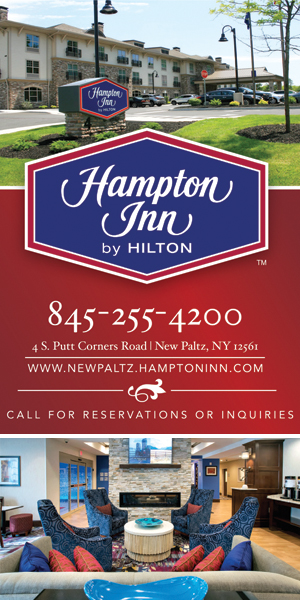Walkway To The Hamlet of Highland’s History
Summer 2011
Walkway Over The Hudson strollers and cyclists can now continue their exploration of the Hudson Valley by following the paved Hudson Valley Rail Trail west, passing under Route 9W, and taking the exit that brings them to the Hamlet of Highland.
The exit is just west of the 9W underpass, and leads up to Tillson Avenue. As you exit, note the lovely white 1845 Ezekiel Elting (now Ossie) home with its unusual ornamental trees.
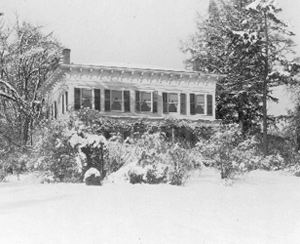
Ossie House
Taking the sidewalk along the south side of Tillson, you will see several Arts and Crafts homes on the opposite side of the street. At the bottom of the Tillson is the Inn at Twaalfskill, named for the rushing stream that passes through the Hamlet on its way to the Hudson. The Inn was built in 1902 as the home of Harcourt Pratt, a local businessman and representative in the United States Congress.
Now, crossing Tillson and heading north on Vineyard Avenue, you will see a replica mill wheel in the Twaalfskill Creek. A mill was once located here, later the property was Pratt’s Lumber, then Vintage Village, today it’s in transition.

Pratt’s Lumber (Vintage Village) w/rail line
Farther along on the opposite side of the street is a large Federal style stone home, the 1846 Jacob Hasbrouck house. Its building stone was quarried from behind the house. During the 1940s and 50s, it was the home of John F. Wadlin, a NYS Assemblyman.
As you proceed along Vineyard you enter the main section of the Hamlet. Once a thriving little village with trolley service, numerous stores, hotels, restaurants, and homes. Today the hamlet is more sedate and peaceful with most traffic whizzing along on Route 9W unaware the Hamlet exists.
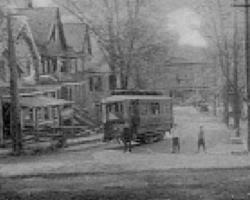
Looking toward Vineyard from Main 1907
Once you enter the business district of the village, the architecture becomes even more varied in style. A number of fires changed entire sections street scape from their 1800s roots as seen above here.

Main Street circa 1935, note diner
Newer stores, such as Rizzi’s Jewelry that has been serving the area since the 1950s, help us move through time with its “modern” facade. Across the street was once a car dealership, later a post office, and is now a day care center.
The Sawyer Savings Bank built in 1923 as the First National Bank of Highland, replaced a clapboard building that had housed Deyo Hall in the early 1900s.

Building on right is now location of Sawyer Bank
The New Paltz-Poughkeepsie Trolley ran from the Hudson River west shore rail station and ferry landing up River Road to Vineyard Avenue, then on Main Street. From there it continued out of town where it met up with the smaller trolley car at Weed’s Mill carrying passengers over the railroad bridge (Walkway) to meet the trolley and continue on to New Paltz and the mountain houses.
At the intersection of Vineyard and Main St., cross to the Sawyer corner. Across the intersection is the large brick Methodist Church, built in 1869. It is pictured in this story as it looked in 1907.

Now a nail salon on Main Street
At the intersection with Church St., the 1905 library building was originally a lovely home, then a medical office to ensure inoculation of children against childhood diseases. To the right of the library is Torsone’s funeral home, and to the right of that is a Masonic lodge. Both buildings, originally homes, are well over a hundred years old.
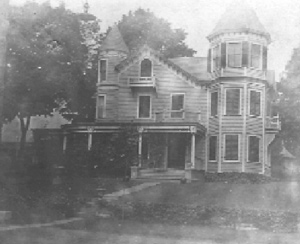
Ganse House, now Highland Free Library
Turing left at what was once the local firehouse, the Presbyterian Church is on your right. Built in 1844, the Greek Revival portico was added in 1871.
Continuing to Vineyard, you will pass the Lloyd Town Hall on your right. Cross Church Street at the intersection, make a right on Commercial Avenue and you can connect on the left, just before the large garages, with the Hudson Valley Rail Trail again. Go left to return to the Walkway, or right to explore the beautiful rock formations and look down on the spectacular Black Creek wetlands with its beaver dams, geese, birds, and interesting flora.
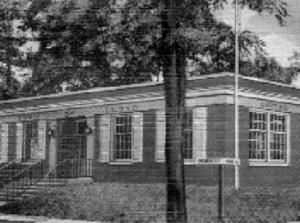
Lloyd Town Hall prior to addition of 2nd story
